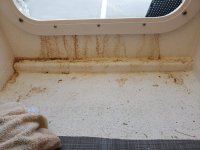Keweenaw2018
New member
- Joined
- Aug 27, 2020
- Messages
- 34
- Reaction score
- 0
- C Dory Year
- 2000
- C Dory Model
- 22 Cruiser
- Vessel Name
- Norppa
So I am currently living aboard (part time) on my 2000 22' Cruiser. I either have a leak, or I am greatly underestimating the amount of moisture that can build up on interior walls on humid/rainy days. I have a welcome mat just inside the cabin door and on rainy or even misty days, I will come home from work or wake up in the morning to find the mat soaked to the bone or even some small puddles on the cabin floor. But I have looked everywhere and can't find an obvious leak. I've checked all the thru fittings and windows and everything I can think of. Does anyone else have this problem. Has anyone been able to resolve or mitigate it. I'm concerned about mold issues.



